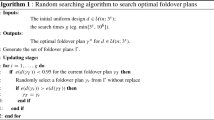Abstract
Follow-up experimentation is often necessary to the successful use of fractional factorial designs. When some effects are believed to be significant but cannot be estimated using an initial design, adding another fraction is often recommended. As the initial design and its foldover (or semifoldover) are usually conducted at different stages, it may be desirable to include a block factor. In this article, we study the blocking effect of such a factor on foldover and semifoldover designs. We consider two general cases for the initial designs, which can be either unblocked or blocked designs. In both cases, we explore the relationships between semifoldover of a design and its corresponding foldover design. More specifically, we obtain some theoretical results on when a semifoldover design can estimate the same two-factor interactions or main effects as the corresponding foldover. These results can be important for those who want to take advantage of the run size savings of a semifoldover without sacrificing the ability to estimate important effects.
Similar content being viewed by others
References
Ai M, Xu X, Wu J (2010) Optimal blocking and foldover plans for regular two-level designs. Stat Sin 20:183–207
Balakrishnan N, Yang P (2006a) Classification of three-word indicator functions of two-level factorial designs. Ann Inst Stat Math 58:595–608
Balakrishnan N, Yang P (2006b) Connections between the resolutions of general two-level factorial designs. Ann Inst Stat Math 58:609–618
Balakrishnan N, Yang P (2009) De-aliasing effects using semifoldover techniques. J Stat Plan Inference 139(9):3102–3111
Barnett J, Czitrom V, John P, Lión L (1997) Using fewer wafers to resolve confounding in screening experiments. In: Czitrom V, Spagon PD (eds) Statistical case studies for industrial process improvement. SIAM, Philadelphia, pp 235–250
Box G, Hunter S, Hunter W (2005) Statistics for experimenters: design, innovation, and discovery. Wiley, New York
Cheng S, Li W, Ye K (2004) Blocked nonregular two-level factorial designs. Technometrics 46(3):269–279
Edwards D (2011) Optimal semifoldover plans for two-level orthogonal designs. Technometrics 53(3):274–284
Fontana R, Pistone G, Rogantin M (2000) Classification of two-level factorial fractions. J Stat Plan Inference 87(1):149–172
Li W, Lin D (2003) Optimal foldover plans for two-level fractional factorial designs. Technometrics 45(2):142–149
Li W, Lin D, Ye K (2003) Optimal foldover plans for two-level nonregular orthogonal designs. Technometrics 45(4):347–351
Mee R, Peralta M (2000) Semifolding \(2^{k-p}\) designs. Technometrics 42(2):122–134
Mee R, Xiao J (2008) Optimal foldovers and semifolding for minimum aberration even fractional factorial designs. J Qual Tech 40(4):448–460
Montgomery D, Runger G (1996) Foldovers of \(2^{k-p}\) resolution \(IV\) experimental designs. J Qual Tech 28(4):446–450
Ou Z, Qin H, Li H (2011) Optimal blocking and foldover plans for nonregular two-level designs. J Stat Plan Inference 141(5):1635–1645
Wu J, Hamada M (2009) Experiments: planning analysis and parameter design optimization. Wiley, New York
Yang P (2013) Optimal blocking and semifoldover plans for \(2^{n-p}\) designs. Stat Probab Lett 83(2):624–630
Yang P, Li W (2014) Blocked two-level semifoldover designs. J Stat Plan Inference 144(1):133–140
Ye K (2003) Indicator function and its application in two-level factorial designs. Ann Stat 31:984–994
Ye K, Li W (2003) Some properties of blocked and unblocked foldovers of \(2^{k-p}\) designs. Stat Sin 13: 403–408
Acknowledgments
The authors would like to express their sincere thanks to the anonymous referee and the editor for their valuable comments and suggestions which led to significant improvement in the presentation and clarity of the paper. Lin’s research was partially supported by the National Science Council of Taiwan (Grant No. NSC 102-2118-M-005-002). Li’s research was supported by the Research and Teaching Supplements system in Carlson School of Management at the University of Minnesota.
Author information
Authors and Affiliations
Corresponding author
Appendix
Appendix
See Table 1.
Rights and permissions
About this article
Cite this article
Yang, P., Lin, CY. & Li, W. Blocked semifoldovers of two-level orthogonal designs. Metrika 78, 529–548 (2015). https://doi.org/10.1007/s00184-014-0514-8
Received:
Published:
Issue Date:
DOI: https://doi.org/10.1007/s00184-014-0514-8



